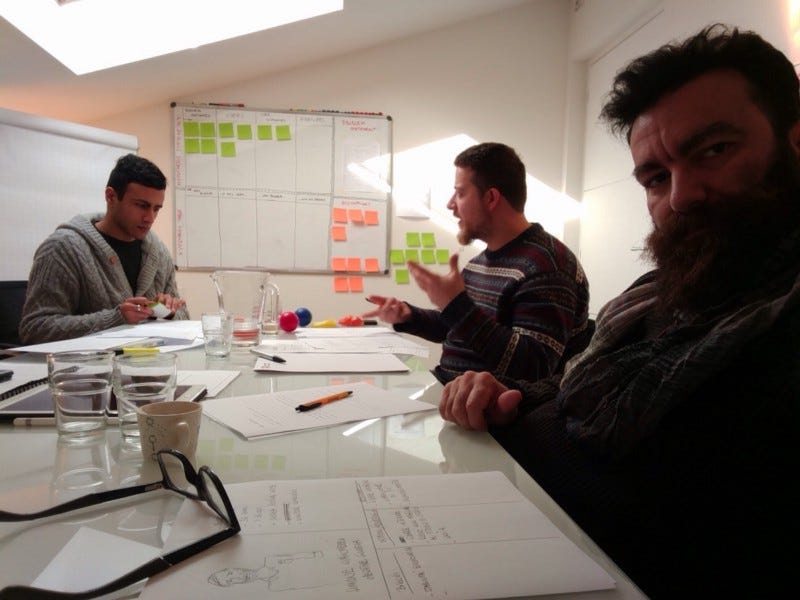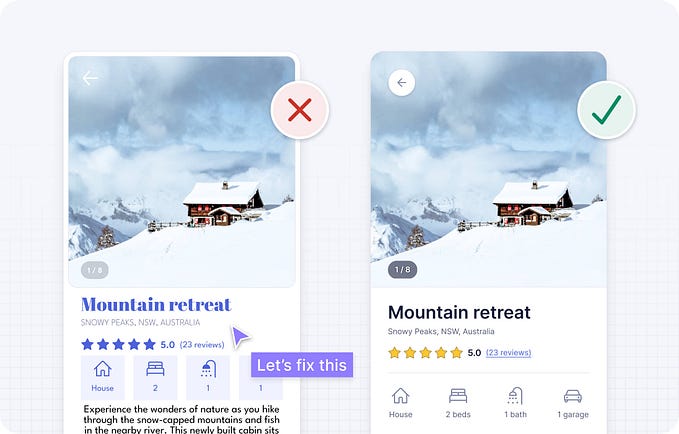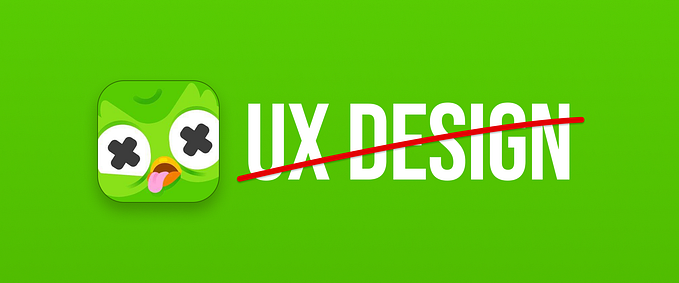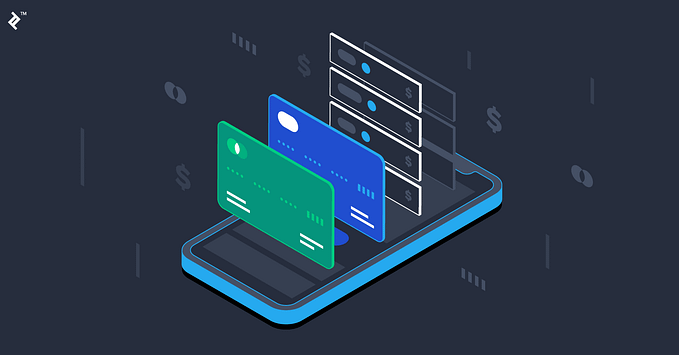
One year ago I was writing a post called “Moving my team to Lean UX”.
It was all about presenting the obstacles and fears of approaching a new way of working.
What does it mean to move a whole team to a new workflow?
It has been one year now since that article, and now it’s time to share with the world what happened.
Did we do it?



In the course of this last year I’ve been doing more than 40 UX workshops with more than 25 different clients of ours, trying to apply Lean UX methodology.
We are a web agency called Lean Panda composed of 20+ developers and designers. Half of our team makes digital products for external clients, and the other half is full-time on DatoCMS, an API-based CMS that recently has been blowing many people’s minds 😏.
So… many different clients, many different products, and this is crucial.
We are not a one-product-focus team, and if you are like us and also interested in Lean UX then this post is for you.
We asked ourselves two big questions for the whole year:
Do web agencies fit Lean UX requirements?
Is Lean UX sellable?
Spoiler: answer is at the end of the post.
One year and a half ago I joined this wonderful team, Lean Panda, and I was asked to do something to improve our inner methodology, with a focus on getting Design and Development sections nearer.
At the time, I had been studying Lean UX for 3 years and I felt like it was the perfect opportunity for me to test it out.
I found a great Agile environment here but UX was really basic: no user research, just heuristic approach with wireframes.
Our last year at Lean Panda has been the year of the implementation of User-Centered Design practices, thanks to our attempt of introducing Lean UX in our projects.
Was it hard?
Hell, yes. But it was worth it.
Let me continue the story. I did a presentation to a few people in my agency basically summing up the book Lean UX by Jeff Gothelf and Josh Seiden (who I will never stop thanking for their work).
There was a lot of skepticism and fear at the beginning, and it’s normal when you are trying to change a workflow that could affect the entire business model.
Everything calmed down when I started experimenting with workshops instead of debating it.
We did a first experimental workshop with two colleagues, and two weeks later (January 2017) we had our first shot with a big client, the Uffizi Museum in Florence.
Here is a sneak peek of that day:

The feedback was very good, and it gave us the strength to go on.
I am saying “we” but actually I was pretty alone in this Lean UX adventure. Until June 2017, when one of the people in charge decided to support me.
From January to June I had some interesting cases like the strategy and design of an app that allows patients to be always in touch with doctors:



We had a first workshop creating the basic elements of our Hypothesis Table and then a Collaborative Design session where we have designed the first MVP related to our first Hypothesis.
Here is the prototype which went out after some weeks of iterations:

The project stopped soon though, because they just needed a simulated prototype to show to a group of investors. There wasn’t time to do many lean iterations. Everything remained hypothetical, I didn’t have the chance to validate anything, neither to create a real Lean UX loop machine.
Never mind, we applied all the Design Thinking exercises explained in Lean UX, and it was enough for the moment.
In June my boss, as I said, started to support me, and since all the new clients were passing from him, we started to do a lot of workshops with the goal of beginning a Lean UX Cycle.
Let’s see quickly two interesting cases:
Case 1: a Golf Club



Introduction:
A well-structured Golf Club called us to help them with the website and with the goal of buying traffic and finding more foreign golf players.
What we did:
During our first Lean UX Workshop it turned out that all foreign golf players are hosted with a very bad approach. They had to pass through unconfortable dirt roads with the car and had to walk five minutes with their bags on shoulders to reach their changing room.
So we never actually worked with the website, and we started many Lean UX iterations trying to solve the structural problems of their club. The client therefore, understanding their bad experience situation, and understanding the Lean UX method, decided to allocate a little budget to improve their structure.
Outcome:
The job was really interesting. Working with a physical product (the Golf Club) instead of a digital one is very exciting, but considering that they weren’t previously intended to allocate budget on enhancing the user experience (they even didn’t know their problems), the job didn’t proceed for more than two months.
Another issue has been the lack of iterations. We did a great job with finding the problem, but we stopped at the moment of problem solving. Everything ended with a big document of an analysis of the issues and a little explanation of how some Lean UX iterations could solve them, but they demonstrated no willing of investing money in that direction.
It was the first time we learnt that:
We need clients who already know they want to spend their money on outcomes and not output.
Case 2: a Copy Center



Introduction:
A Copy Center divided in five offices all around Florence, asked us to create a management tool to improve the workflow of their 15+ employees.
What we did:
The owner of the business came with clear ideas of wireframes and user flows, but I was puzzled about the fact that his never tested and pretty big version of the application would really enhance his employees performances. At that time employees were all accomplishing each task with some pretty functional sheets of paper.
He was immovable from his idea, so I decided to create a complete working prototype (using atomic.io which I suggest if you don’t master Framer). Then I went to his Copy Center and conducted a Usability Test for each employee.
It turned out that his idea slowed down 6x times the workflow of his employees, demonstrated with a stopwatch, comparing tasks made before with their analogical approach and then with our tool idea.
That was the key! Because after that the owner decided to completely marry a Lean UX approach, and right now it is still our most accurate Lean UX project. 🎉
All his employees are now working with a great management tool. We started immediately with a super lean MVP, and we did a total of 40+ employee interviews and user testings.
Conclusions:
No matter how much you explain Lean UX to people. They need to fail once, after that they have a possibility to decide for a Lean UX approach.
And
Yes, we did it. We completed a real Lean UX project for an external client.
🎉 🎉 🎉
Is this the only Lean UX project you did?
No, but I think it’s the most Lean UX compliant one. Unlike the “Golf Club” case, this project respected many of the Lean UX principles (listed at the end of this post) and regularly created and tested little MVPs for many months. Actually we are still on it, and the client decided to allocate a new budget for this year.
Other cases?
Well we have more than 20 other cases from Summer 2017 to now (February 2018) but none of them as Lean UX as the last I’ve just spoken about.
I wouldn’t go in detail but I can say this:
- 80% of these cases were brochure or e-commerce websites. Not really suitable for a Lean UX approach. Despite this, we created a form of workshop with elements of Lean UX and applied it in this context. It really works and has many interesting commercial aspects (we are about to write a detail post about this approach).
- 20% of our cases instead were mobile apps and tools. I have to say that we had two major requests of developing a mobile app, and they both failed this way: those people were charmed by the methodology, but were too afraid to allocate budget for outcomes and not output. They preferred to associate their money to their very clear idea of mobile app compared to associating it to a path of research. Why? Because they didn’t fail once, and don’t know the obscure world of Waterfall.
So it is a matter of entrepreneurial maturity, we can’t brainwash people with Lean UX, they need to experience failure and then they are ready for more sophisticated approach.
But where are these types of mature client?
Are they probably already set with their own startup? 😁
Let’s move to Pros and Cons of our Lean UX journey.
So, did you do it?
In one year just 1 case out of 25+ in our agency is a real Lean UX project.
And it’s the Copy Center we spoke about.
1 out of 25 seems a little result but it’s not. It tells us that it is possible.
But mostly, we achieved a lot of other things in one year thanks to Lean UX experimentations:
- We implemented the use of many UX practices: Personas, Mental models, User journey maps, problems and goals analysis, user testing based on mental models, user interviews, collaborative design session, hypothesis table, and so on (we didn’t have any of these before).
- We started to sell UX strategy consulting.
- We now have less meetings, more workshops.
- The potential client is impressed by the methodology, so he releases a budget more willingly
The client is hand guided through workshops and many explanations. He learns a lot of things also useful for his offline business.
Frequent quote: “In many years of dealing with people entering my shop, I’ve never watched them this way”. - We avoid a lot of “Hey, I would like to add this section or this feature” on the run, because, from the beginning, we set the whole thing like any feature has to be reasoned by a UX study.
- Thanks to the professionalism we provide, we have increased our quotes from 20% to 40% in the last year.
But have you integrated Lean UX as it is explained by Jeff Gothelf in his book?
Nope.
I mean, we switched from an Agile agency to a quite UX-based agency. But what about a Lean UX-based agency?
To date, nope. We are still trying, it is damn difficult, but we know it’s possible. An example is Tangible.is, an Italian design agency who had the pleasure to host Jeff Gothelf for a full-day workshop:

Today they sell Lean UX services, and it looks like they are going well.
We know even people, and I am talking about an agency which we admire a lot, Sketchin, who studied Lean UX but found some critical issues (article is in Italian) as well as good points. They already have their own internal methodology though, and I think that studying Lean UX has been useful for perfecting it.
Said this, here is a list of obstacles we found which are completely related to our web agency nature.
Spoiler: one-product-focus teams are perfect fits for Lean UX (startups, enterprises).
The best way to explain our obstacles is to list Lean UX principles, as they are written from Jeff Gothelf, and tell if we did it ✔️ or not ❌.
I really want to thank Jeff Gothelf and Josh Seiden for their wonderful job, and I hope it is not a problem if I summarise here a little part of their book (the Principles’ section).
It has the only scope of explaining which are our achievements. If you want to get started in Lean UX your first thing is to read their book. It’s impossible to begin experimenting just reading posts on the internet.

Lean UX principles: done or not?
For those who are not confidential with Lean UX principles I’ll let you know that they are an important part of the book. Basically the book is very technical, with lots of exercises to learn, but it even presents this part, that I really believe is the core system of Lean UX.
I think that any team could say “Yes, we are Lean UX based” if every component is aligned and acts according to these principles.
So let’s see what has been our alignment.
Principles to Guide Team Organization:
1) Cross-functional teams
What is it?
Every component of the team operates with his role but participates to each other role.
Did you do it?
✔️ 3% Yes
❌ 97% No
Why?
3% because we just did it once, in a very small team (two people). In our web agency each component of the team has an hourly cost, so if a job is done by two people it costs double the price compared to the job done by one person.
The times we did it with a medium/big team, costs increased so much that it has been difficult to explain to our client.
2) Small, dedicated, collocated
What is it?
Your team should be less than 10 people, dedicated all to one project, and collocated all in the same location.
Did you do it?
Small: ✔️ Yes
Dedicated ❌ No
Collocated ✔️ Yes
Why?
The dedicated point is very difficult in a web agency when one developer has to deal with different projects.
3) Self-sufficient and empowered
What is it?
It’s about giving your team all the power to interact with their customers and provide solutions without being blocked by external dependencies.
Did you do it?
✔️ Yes
4) Problem-focused team
What is it?
We give our team a problem to solve instead of some features to implement.
Did you do it?
❌ No
Why?
We had two problems here:
- Our clients want to pay for outputs and not outcomes, as I said before.
- Even if we find the perfect client who pays for outcomes, then it’s not the whole team solving problems but just the UXD. Why? Because of the missing of principle 1 and 2.
Principles to Guide Culture:
5) Moving from doubt to certainty
What is it?
We start a project with assumptions, assuming that we solve problems. Assumptions begin in a state of doubt and evolve to certainty.
Did you do it?
✔️ 20% Yes
❌ 80% No
Why?
❌ No in projects like brochure websites. We found very difficult to continue the process of user discovery and lean iterations for this very simple products.
✔️ Yes in projects like tools or mobile apps, because they focus more on the User Experience.
6) Outcomes, not output
Same answer of principle 4.
7) Removing waste
What is it?
If it doesn’t lead us to the goal, and if it is not concerning the study of the mental models of our personas, remove it.
Did you do it?
✔️Yes
Why?
Because explaining that every feature is born with a precise procedure which crosses our goals with users’ behaviours is very effective. So clients tend to be prudent in proposing new features.
8) Shared Understanding
What is it?
The more we understand solutions together, the more we move on faster and spend less time on meetings.
Did you do it?
✔️No
Why?
Same reason: the time we spend less on meetings is not as long as the time of all the components of the team being together in each session. Furthermore, components of the team are not always available because they work in different projects (and this is unavoidable).
9) No rockstars, gurus, or ninjas
What is it?
No experienced people telling us what to do. Testing is our guru.
Did you do it?
✔️Yes! And we love this.
10) Permission to fail
What is it?
Failing is the best way to learn.
Did you do it?
✔️90% Yes
❌ 10% No
Why?
✔️ Yes when the stakeholder is the boss of the business (or very near to him). Because we fail together with the stakeholder. He is with us crafting the product and conducting tests, and feel responsible for the errors too.
❌ No when the stakeholder has to explain everything to a superior boss or group of people.
Principles to Guide Process:
11) Work in small batches to mitigate risk
What is it?
We move step by step in little pieces and we avoid big inventory of untested design ideas.
Did you do it?
✔️ Yes
12) Continuous discovery
What is it?
We schedule regularly the monitoring of what your users are doing and why.
Did you do it?
✔️30% Yes
❌ 70% No
Why?
✔️ Yes for people who understood the importance of Personas and therefore allocate a budget to investigate on them.
❌ No for people who are happy with Proto-Personas and don’t know that validation allows a lot of change to our initial analysis.
13) GOOB “Getting Out Of the Building”
What is it?
It is literally going in your client’s location, going out of your office. In this amazing experiment a digital agency moved their office inside the client’s shop, and the gap between the Lean UX phases “Build” and “Test” drastically reduced.
Did you do it?
✔️30% Yes
❌ 70% No
Why?
✔️ Yes for small teams.
❌ No for big teams.
14) Externalizing your work
What is it?
Trying to publish your current work continuously to other.
Did you do it?
✔️Yes
Why?
Because we do standups everyday and sprint plan weekly.
15) Making over analysis
What is it?
The time you spend debating on an idea is the same time you spend creating it. So let’s focus on creating then debating basing the debate on results and not ideas rather than personal experience.
Did you do it?
✔️Yes
How?
With the help of quick prototyping tool like Atomic or Framer.
16) Getting out of the deliverables business
Same answer of principle 6 and 4.
Conclusions
If one of the initial question was:
Can we do Lean UX with external clients?
To date, our one year experience led us to this:
- Lean UX is difficult for web agencies but not impossible
- You have to sell yourself as a strategy agency
- Brochure websites are not very suitable for Lean UX
- You have to find clients who are willing to invest on outcomes and not outputs
- Lean UX is difficult for very structured clients (like state bodies with a lot of different departments, offices, etc.). Decision making is to uncentered and many times the ultimate boss doesn’t care anything about learning a new methodology.
I am very curious to know what other folks think about this topic.
Feel free to write a comment and thanks for the attention!










